Lexus IS300h 2013 Service Manual
Manufacturer: LEXUS, Model Year: 2013, Model line: IS300h, Model: Lexus IS300h 2013Pages: 628, PDF Size: 20.23 MB
Page 41 of 628
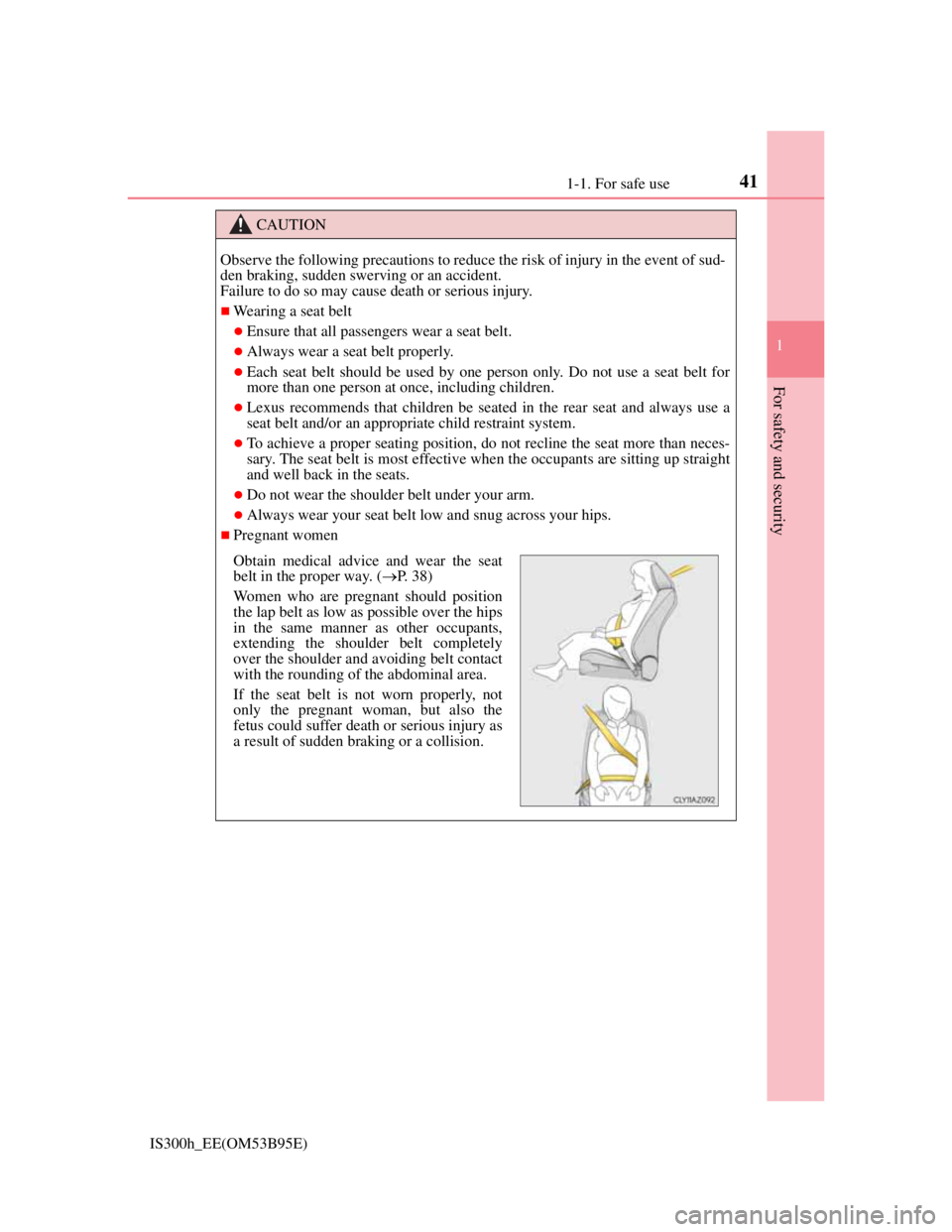
411-1. For safe use
1
For safety and security
IS300h_EE(OM53B95E)
CAUTION
Observe the following precautions to reduce the risk of injury in the event of sud-
den braking, sudden swerving or an accident.
Failure to do so may cause death or serious injury.
Wearing a seat belt
Ensure that all passengers wear a seat belt.
Always wear a seat belt properly.
Each seat belt should be used by one person only. Do not use a seat belt for
more than one person at once, including children.
Lexus recommends that children be seated in the rear seat and always use a
seat belt and/or an appropriate child restraint system.
To achieve a proper seating position, do not recline the seat more than neces-
sary. The seat belt is most effective when the occupants are sitting up straight
and well back in the seats.
Do not wear the shoulder belt under your arm.
Always wear your seat belt low and snug across your hips.
Pregnant women
Obtain medical advice and wear the seat
belt in the proper way. (P. 38)
Women who are pregnant should position
the lap belt as low as possible over the hips
in the same manner as other occupants,
extending the shoulder belt completely
over the shoulder and avoiding belt contact
with the rounding of the abdominal area.
If the seat belt is not worn properly, not
only the pregnant woman, but also the
fetus could suffer death or serious injury as
a result of sudden braking or a collision.
Page 42 of 628

421-1. For safe use
IS300h_EE(OM53B95E)
CAUTION
People suffering illness
Obtain medical advice and wear the seat belt in the proper way. (P. 38)
When children are in the vehicle
Do not allow children to play with the seat belt. If the seat belt becomes twisted
around a child’s neck, it may lead to choking or other serious injuries that could
result in death.
If this occurs and the buckle cannot be unfastened, scissors should be used to
cut the belt.
Seat belt pretensioners
If the pretensioner has activated, the SRS warning light will come on. In that
case, the seat belt cannot be used again and must be replaced at any authorized
Lexus dealer or repairer, or another duly qualified and equipped professional.
Adjustable shoulder anchor
Always make sure the shoulder belt is positioned across the center of your
shoulder. The belt should be kept away from your neck, but not falling off your
shoulder. Failure to do so could reduce the amount of protection in an accident
and cause death or serious injuries in the event of a sudden stop, sudden swerve
or accident. (P. 3 9 )
Seat belt damage and wear
Do not damage the seat belts by allowing the belt, plate, or buckle to be
jammed in the door.
Inspect the seat belt system periodically. Check for cuts, fraying, and loose
parts. Do not use a damaged seat belt until it is replaced. Damaged seat belts
cannot protect an occupant from death or serious injury.
Ensure that the belt and plate are locked and the belt is not twisted.
If the seat belt does not function correctly, immediately contact any autho-
rized Lexus dealer or repairer, or another duly qualified and equipped profes-
sional.
Replace the seat assembly, including the belts, if your vehicle has been
involved in a serious accident, even if there is no obvious damage.
Do not attempt to install, remove, modify, disassemble or dispose of the seat
belts. Have any necessary repairs carried out by any authorized Lexus dealer
or repairer, or another duly qualified and equipped professional. Inappropriate
handling may lead to incorrect operation.
Page 43 of 628
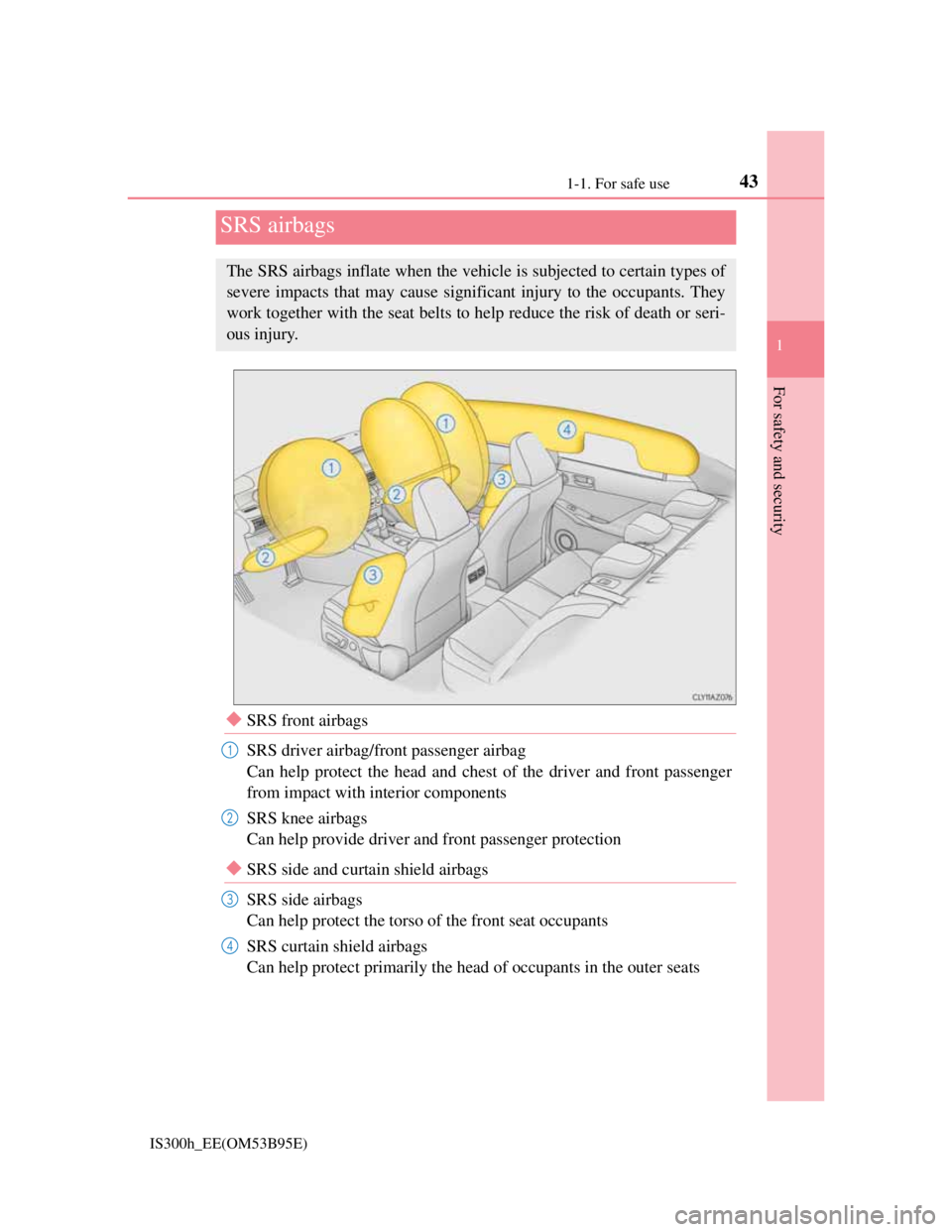
431-1. For safe use
1
For safety and security
IS300h_EE(OM53B95E)
SRS front airbags
SRS driver airbag/front passenger airbag
Can help protect the head and chest of the driver and front passenger
from impact with interior components
SRS knee airbags
Can help provide driver and front passenger protection
SRS side and curtain shield airbags
SRS side airbags
Can help protect the torso of the front seat occupants
SRS curtain shield airbags
Can help protect primarily the head of occupants in the outer seats
SRS airbags
The SRS airbags inflate when the vehicle is subjected to certain types of
severe impacts that may cause significant injury to the occupants. They
work together with the seat belts to help reduce the risk of death or seri-
ous injury.
1
2
3
4
Page 44 of 628
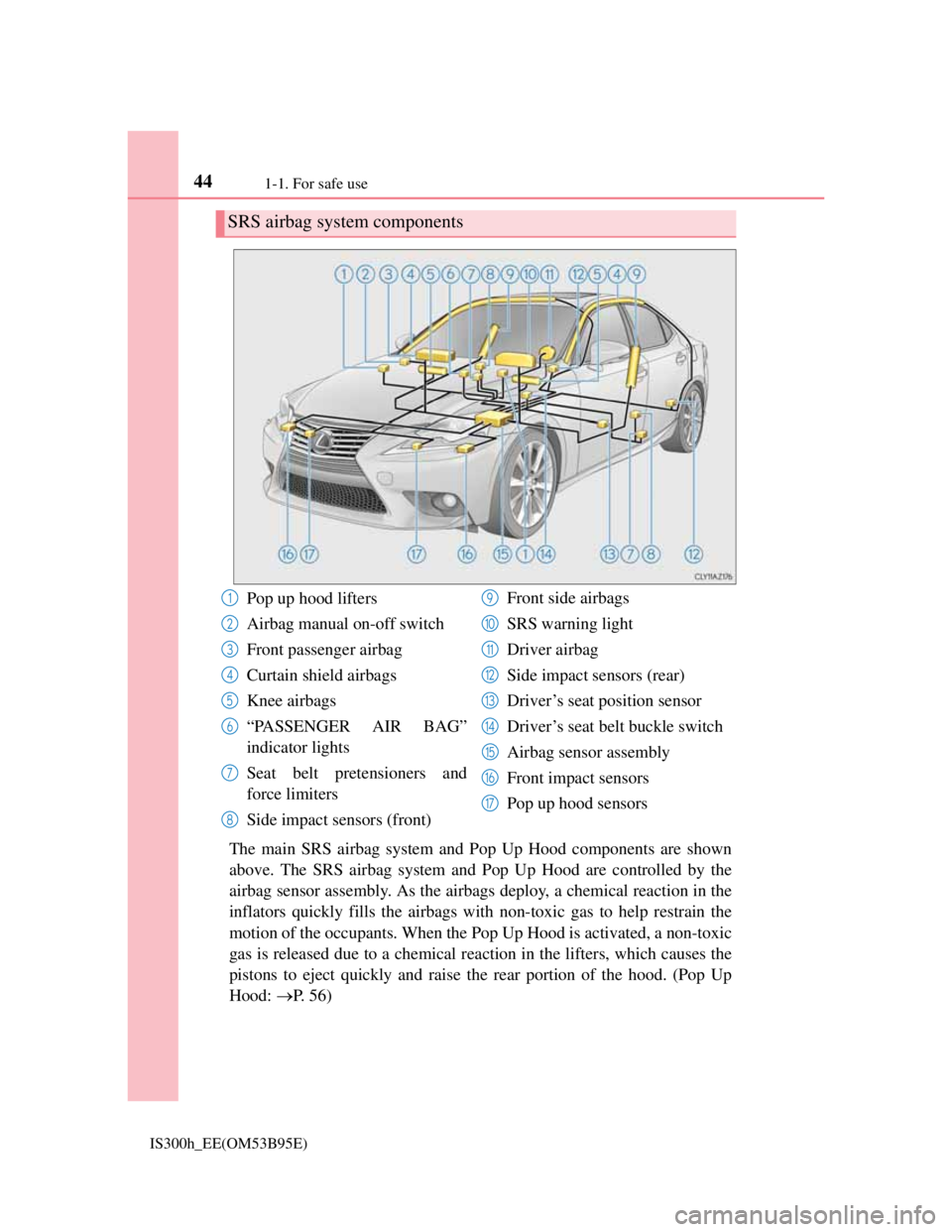
441-1. For safe use
IS300h_EE(OM53B95E)
The main SRS airbag system and Pop Up Hood components are shown
above. The SRS airbag system and Pop Up Hood are controlled by the
airbag sensor assembly. As the airbags deploy, a chemical reaction in the
inflators quickly fills the airbags with non-toxic gas to help restrain the
motion of the occupants. When the Pop Up Hood is activated, a non-toxic
gas is released due to a chemical reaction in the lifters, which causes the
pistons to eject quickly and raise the rear portion of the hood. (Pop Up
Hood: P. 56)
SRS airbag system components
Pop up hood lifters
Airbag manual on-off switch
Front passenger airbag
Curtain shield airbags
Knee airbags
“PASSENGER AIR BAG”
indicator lights
Seat belt pretensioners and
force limiters
Side impact sensors (front)Front side airbags
SRS warning light
Driver airbag
Side impact sensors (rear)
Driver’s seat position sensor
Driver’s seat belt buckle switch
Airbag sensor assembly
Front impact sensors
Pop up hood sensors1
2
3
4
5
6
7
8
9
10
11
12
13
14
15
16
17
Page 45 of 628

451-1. For safe use
1
For safety and security
IS300h_EE(OM53B95E)
CAUTION
SRS airbag precautions
Observe the following precautions regarding the SRS airbags.
Failure to do so may cause death or serious injury.
The driver and all passengers in the vehicle must wear their seat belts prop-
erly.
The SRS airbags are supplemental devices to be used with the seat belts.
The SRS driver airbag deploys with considerable force, and can cause death
or serious injury especially if the driver is very close to the airbag.
Since the risk zone for the driver’s airbag is the first 50 - 75 mm (2 - 3 in.) of
inflation, placing yourself 250 mm (10 in.) from your driver airbag provides
you with a clear margin of safety. This distance is measured from the center
of the steering wheel to your breastbone. If you sit less than 250 mm (10 in.)
away now, you can change your driving position in several ways:
• Move your seat to the rear as far as you can while still reaching the pedals
comfortably.
• Slightly recline the back of the seat.
Although vehicle designs vary, many drivers can achieve the 250 mm (10
in.) distance, even with the driver seat all the way forward, simply by
reclining the back of the seat somewhat. If reclining the back of your seat
makes it hard to see the road, raise yourself by using a firm, non-slippery
cushion, or raise the seat if your vehicle has that feature.
• If your steering wheel is adjustable, tilt it downward. This points the airbag
toward your chest instead of your head and neck.
The seat should be adjusted as recommended above, while still maintaining
control of the foot pedals, steering wheel, and your view of the instrument
panel controls.
Page 46 of 628
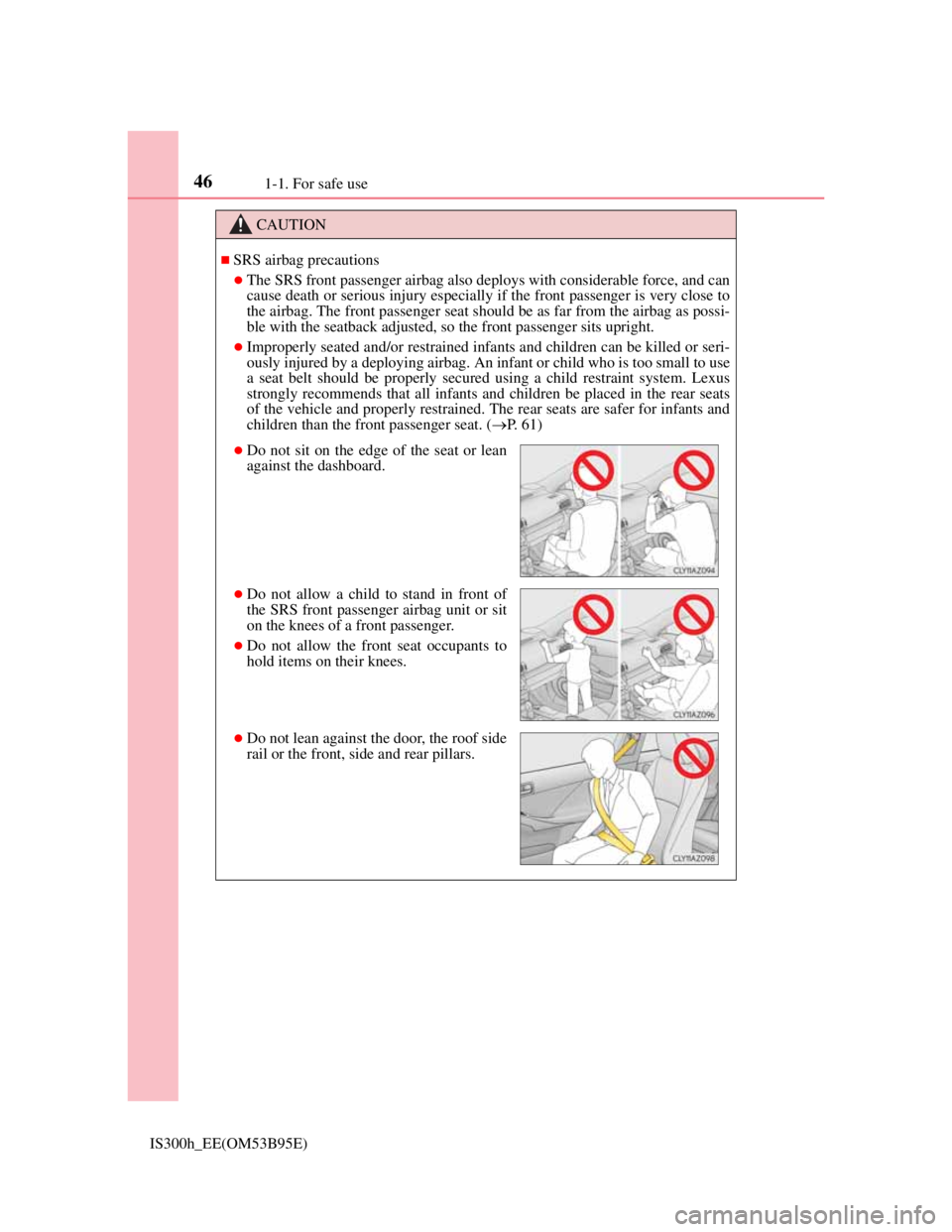
461-1. For safe use
IS300h_EE(OM53B95E)
CAUTION
SRS airbag precautions
The SRS front passenger airbag also deploys with considerable force, and can
cause death or serious injury especially if the front passenger is very close to
the airbag. The front passenger seat should be as far from the airbag as possi-
ble with the seatback adjusted, so the front passenger sits upright.
Improperly seated and/or restrained infants and children can be killed or seri-
ously injured by a deploying airbag. An infant or child who is too small to use
a seat belt should be properly secured using a child restraint system. Lexus
strongly recommends that all infants and children be placed in the rear seats
of the vehicle and properly restrained. The rear seats are safer for infants and
children than the front passenger seat. (P. 61)
Do not sit on the edge of the seat or lean
against the dashboard.
Do not allow a child to stand in front of
the SRS front passenger airbag unit or sit
on the knees of a front passenger.
Do not allow the front seat occupants to
hold items on their knees.
Do not lean against the door, the roof side
rail or the front, side and rear pillars.
Page 47 of 628
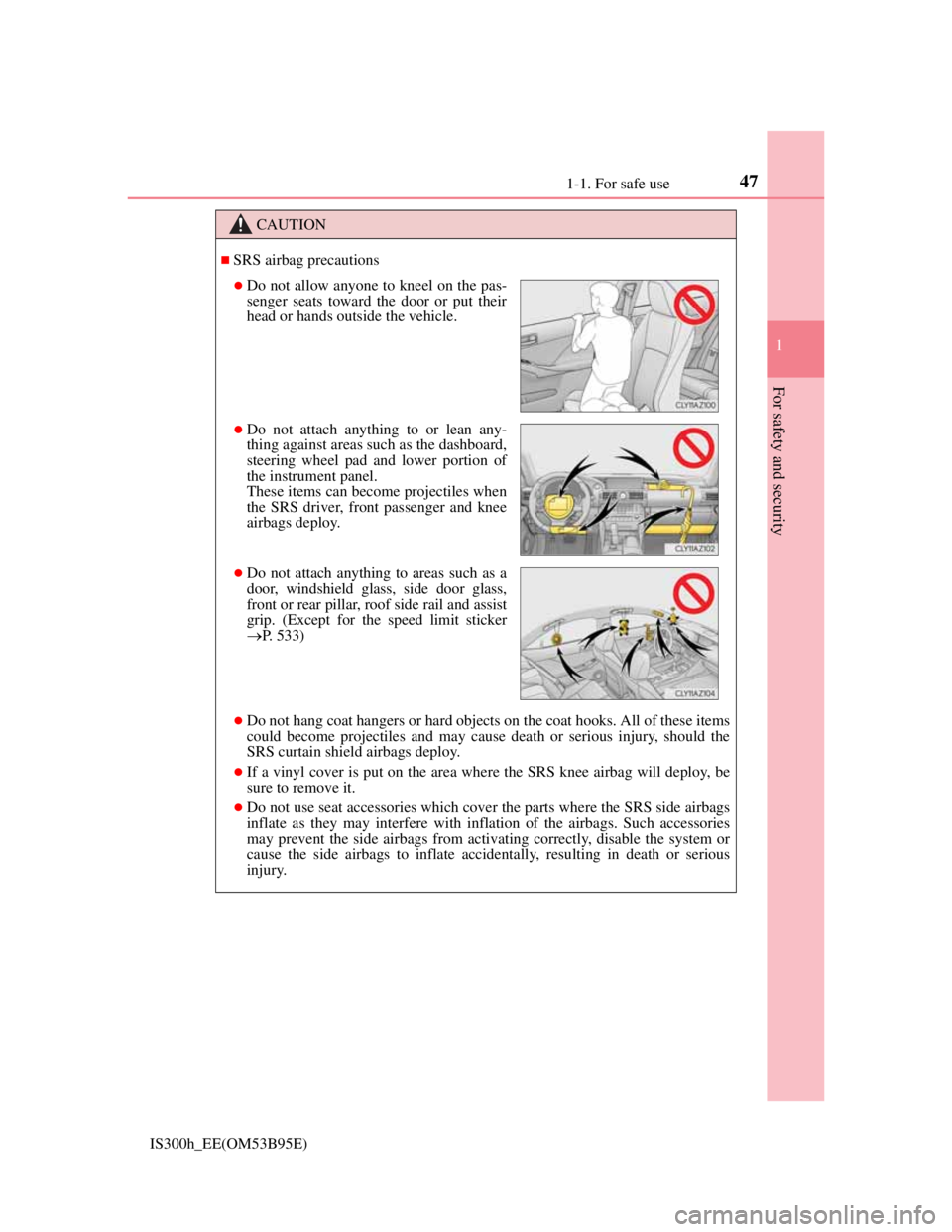
471-1. For safe use
1
For safety and security
IS300h_EE(OM53B95E)
CAUTION
SRS airbag precautions
Do not hang coat hangers or hard objects on the coat hooks. All of these items
could become projectiles and may cause death or serious injury, should the
SRS curtain shield airbags deploy.
If a vinyl cover is put on the area where the SRS knee airbag will deploy, be
sure to remove it.
Do not use seat accessories which cover the parts where the SRS side airbags
inflate as they may interfere with inflation of the airbags. Such accessories
may prevent the side airbags from activating correctly, disable the system or
cause the side airbags to inflate accidentally, resulting in death or serious
injury.
Do not allow anyone to kneel on the pas-
senger seats toward the door or put their
head or hands outside the vehicle.
Do not attach anything to or lean any-
thing against areas such as the dashboard,
steering wheel pad and lower portion of
the instrument panel.
These items can become projectiles when
the SRS driver, front passenger and knee
airbags deploy.
Do not attach anything to areas such as a
door, windshield glass, side door glass,
front or rear pillar, roof side rail and assist
grip. (Except for the speed limit sticker
P. 533)
Page 48 of 628

481-1. For safe use
IS300h_EE(OM53B95E)
CAUTION
SRS airbag precautions
Do not strike or apply significant levels of force to the area of the SRS airbag
components.
Doing so can cause the SRS airbags to malfunction.
Do not touch any of the component parts immediately after the SRS airbags
have deployed (inflated) as they may be hot.
If breathing becomes difficult after the SRS airbags have deployed, open a
door or window to allow fresh air in, or leave the vehicle if it is safe to do so.
Wash off any residue as soon as possible to prevent skin irritation.
If the areas where the SRS airbags are stored, such as the steering wheel pad
and front and rear pillar garnishes are damaged or cracked, have them
replaced by any authorized Lexus dealer or repairer, or another duly qualified
and equipped professional.
Modification and disposal of SRS airbag system components
Do not dispose of your vehicle or perform any of the following modifications
without consulting any authorized Lexus dealer or repairer, or another duly
qualified and equipped professional. The SRS airbags may malfunction or
deploy (inflate) accidentally, causing death or serious injury.
Installation, removal, disassembly and repair of the SRS airbags
Repairs, modifications, removal or replacement of the steering wheel, instru-
ment panel, dashboard, seats or seat upholstery, front, side and rear pillars or
roof side rails
Repairs or modifications of the front fender, front bumper, or side of the occu-
pant compartment
Installation of snow plows, winches, etc. to the front grille (bull bars or kan-
garoo bar etc.)
Modifications to the vehicle’s suspension system
Installation of electronic devices such as mobile two-way radios, RF-trans-
mitters and CD players
Modifications to your vehicle for a person with a physical disability
Page 49 of 628

491-1. For safe use
1
For safety and security
IS300h_EE(OM53B95E)
If the SRS airbags deploy (inflate)
Bruising and slight abrasions may result from contact with a deploying (inflat-
ing) SRS airbag.
A loud noise and white powder will be emitted.
Parts of the airbag module (steering wheel hub, airbag cover and inflator) as
well as the front seats, parts of the front and rear pillars, and roof side rails, may
be hot for several minutes. The airbag itself may also be hot.
The windshield may crack.
SRS airbag deployment conditions (SRS front airbags)
The SRS front airbags will deploy in the event of an impact that exceeds the set
threshold level (the level of force corresponding to an approximately 20 - 30
km/h [12 - 18 mph] frontal collision with a fixed wall that does not move or
deform).
However, this threshold velocity will be considerably higher in the following
situations:
• If the vehicle strikes an object, such as a parked vehicle or sign pole, which
can move or deform on impact
• If the vehicle is involved in an underride collision, such as a collision in
which the front of the vehicle “underrides”, or goes under, the bed of a truck
Depending on the type of collision, it is possible that only the seat belt preten-
sioners will activate.
SRS airbag deployment conditions (SRS side and curtain shield airbags)
The SRS side and curtain shield airbags will deploy in the event of an impact
that exceeds the set threshold level (the level of force corresponding to the
impact force produced by an approximately 1500 kg [3300 lb.] vehicle collid-
ing with the vehicle cabin from a direction perpendicular to the vehicle orienta-
tion at an approximate speed of 20 - 30 km/h [12 - 18 mph]).
The SRS curtain shield airbags may also deploy in the event of a severe frontal
collision.
Page 50 of 628
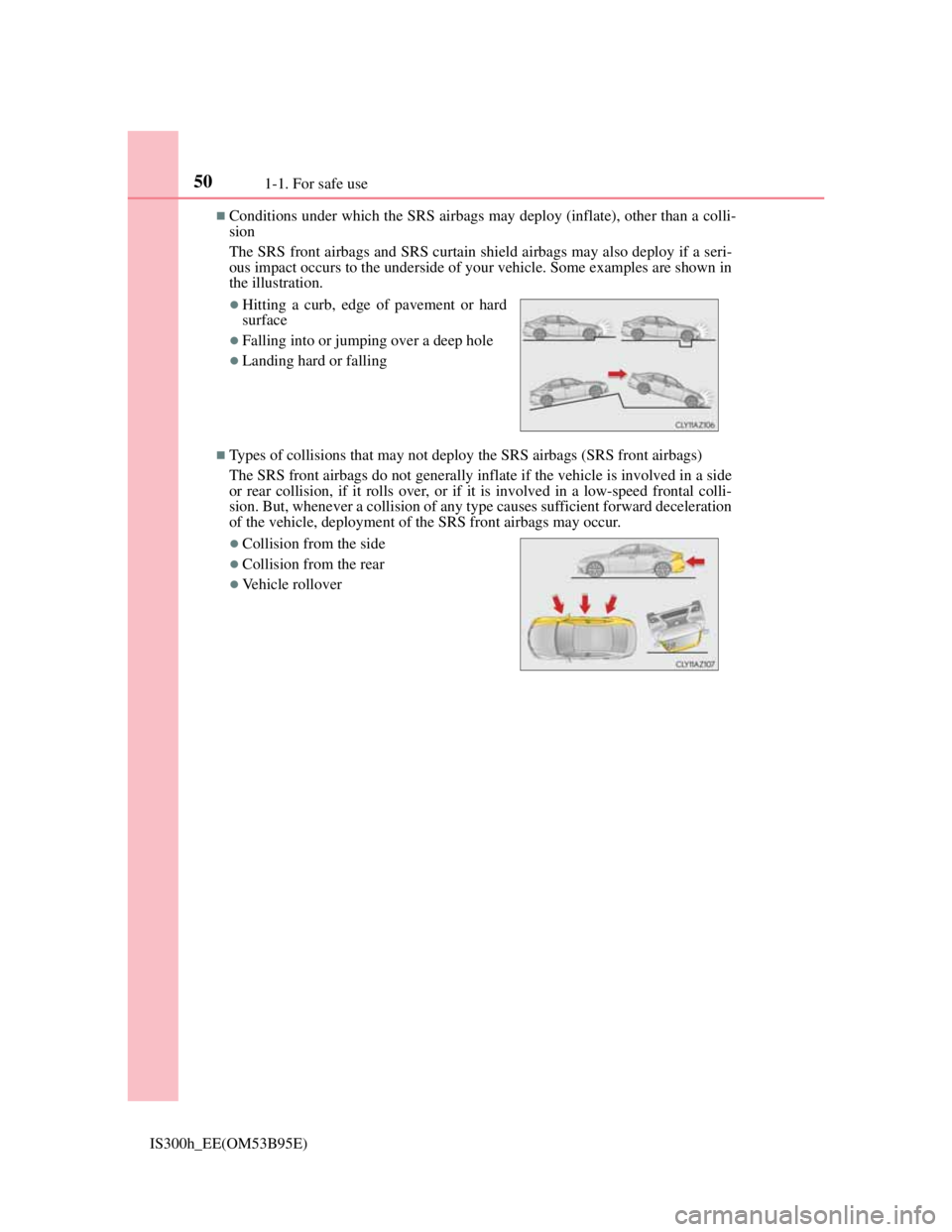
501-1. For safe use
IS300h_EE(OM53B95E)
Conditions under which the SRS airbags may deploy (inflate), other than a colli-
sion
The SRS front airbags and SRS curtain shield airbags may also deploy if a seri-
ous impact occurs to the underside of your vehicle. Some examples are shown in
the illustration.
Types of collisions that may not deploy the SRS airbags (SRS front airbags)
The SRS front airbags do not generally inflate if the vehicle is involved in a side
or rear collision, if it rolls over, or if it is involved in a low-speed frontal colli-
sion. But, whenever a collision of any type causes sufficient forward deceleration
of the vehicle, deployment of the SRS front airbags may occur.
Hitting a curb, edge of pavement or hard
surface
Falling into or jumping over a deep hole
Landing hard or falling
Collision from the side
Collision from the rear
Vehicle rollover